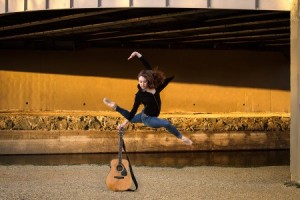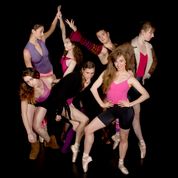Guest Post: An Informal Introduction to MOVEiUS Ballets
May 29, 2013 Leave a comment
By Helen Gineris
MOVEiUS Contemporary Ballet is forging a path and making a home for classically-trained talent in the Greater Metro DC area. On Saturday, May 18, the company extended an invitation to Meet MOVEiUS, a casual studio showing of five works comprising old, newer, and in-progress pieces by four choreographers. Hosted at Takoma Park’s infamous Dance Exchange, the audience sat in three rows of folding chairs and overstuffed pillows at the rear of a large, Marley-floor dance studio. The intimate evening flowed quickly with each production headlined with introductory commentary allowing for an insider perspective rarely offered to dance audiences.
Verge
Indicative that the casual studio setting is new to some, the immediate start of Florian Rouiller’s “Verge” (2013) is met with curious whispers observing the absence of “special” lighting. Soloist Kathleen Howard performs with adeptness, strength, and control, a dancer whose classical technique shines in graceful arm and leg extensions and fluid movement atop a supported frame. Contemporary contractions and body waves complement the classical style while turning leaps excite. On its own the composition is well-structured, uses the entire space and depth of the stage, and keeps the audience traveling along with the soloist. Musically speaking, set to nuevo tango “Santa Maria Del Buen Ayre” by GoTan Project, a song of passionate beats, sharp crescendos, and intricate electronica, a disconnect is present. Perhaps the casual studio atmosphere and absent stage-lighting contribute to the lost translation of musical strength and passion or presence of “verge;” the overall impression urges an embrace of the choreography with a reevaluation of musical choice or a definitive nose-dive into the multi-layered bounty of musical tensions, tones, and tempos until they emerge inseparable from the existing choreography.
SINS/Learning to Run
By contrast, “SINS,” alternately titled “The Sun is Not Sinking” (2013) proves captivating in the exquisite musicality present in the choreographic phraseology and internalization of it by the four dancers down to the last detail, from emotive facial expressions to head turns creating lines of sight that help the audience know exactly where to focus their attention throughout the piece. As a studio showing, the forced physical presence of the main character or trio on the sidelines, where they would normally be hidden in the wings, lends an even greater distinction to the relationships played out on stage. Throughout, the movements, at times deliciously subtle, mesmerize. Choreographed by MOVEiUS Associate Director Katya Vasilaky, who also performs in the piece, SINS is a collaborative work between four dancers who convey a graceful sense of trust, support, and closeness on stage.
MOVEiUS Founder/Executive Director and choreographer Diana Movius presented a preview of “Learning to Run” (2013) followed by “Legacy” (2011, restaged 2013). Set to minimalist modern music by Steve Reich, in “Learning to Run” Movius presents a fast, slow, fast mood-changing piece evoking the contradictions and motivations of modern-day life.
Legacy
“Legacy,” which premiered at Dance Place in 2011, is well-traveled both in and out of state and debuting its first restaging on an entirely new cast at Meet MOVEiUS. As the choreographer, Movius reveals that restaging produces a new dance influenced by the capabilities and strengths of individual dancers; meanwhile, the music, structure, and “emotional core of what our relationships mean throughout our lives” remain the work’s constants. As the piece opens two dancers in child’s pose are approached by a counterpart who steps behind each to raise them up with the soft wave and rise of a hand and arm as if growing flowers out of a garden – budding, sprouting, and opening up to the light. Staccato rhythms of pointe shoes paired with outstretched arms and legs carve an “X” in the space inducing excitement as if to say “Hello! I’m here!” and so the relationships begin. Movius’ beautiful composition takes the audience on an intricate journey through relationship evolutions such as dependence, support, excitement, growing up, standing on one’s own, letting go, remembrance, and reverence. It’s easy to see why this is a repertory mainstay.
Big River
Closing the evening is a four-song preview of “Big River” (2013) performed to music sung by Johnny Cash. Inspired by Cash’s lifetime of music, choreographer Kimberly Parmer boldly attaches contemporary ballet to a well-known and loved, definitively iconic American figure whose artistic career spans 50 years and fan-base crosses generations. In choosing Cash, the ballet is no longer being performed to “dance-viewers,” but to dance-viewers who reside somewhere along a Johnny Cash fan continuum and whose level of fandom will undoubtedly affect one’s experience of the ballet. It has the potential to knock Johnny Cash fans out of their train cars as they uncover how their fandom is shaped with preconceived notions, already-established emotions and images attached to Cash’s musical work and revealed only in the process of seeing that work translated onto another artistic medium.
The ballet is set within a framework of values derived from Eric Erickson’s eight stages of psychosocial development. Parmer emphasizes that “Big River” is very much a work-in-progress in the rehearsal phases with dancers still trying on and internalizing the movements. The six-dancer ballet begins with the end in mind, at the end of Cash’s career, with the song “Unchained” (Jude Johnstone). Breaking from tradition, the tallest dancer leads the front adding depth to the stage while the group plays out the passage of time in waves of diagonal lines. Repetitive hip twists depart from the classical linear tradition and the sound of pointe shoes add a surprising beat on top of the music as the ballet turns to “Folsom Prison Blues” to explore the sentiment hope. The piece proves a disconcerting juxtaposition between exuberant leaps, lightness, and smiles (hope) and gritty, at times fatalistic lyrics, From the infamous “I shot a man in Reno just to watch him die” to “I know I had it comin’, I know I can’t be free.” It begs to know from what perspective hope is being explored. Is it inspired by the last stanza, the catchy, rhythmic tempo surrounding the lyrics, perhaps an absence of hope, or simply that Cash’s career is beginning? The highlight of the ballet is “Got Rhythm,” a refreshing, upbeat tap solo with sounds and contemporary moves not to be missed, performed en pointe by Shelley Siller. Typical of a work-in-progress, the preview arouses more questions before presenting a definitive piece. Provocative, “Big River,” centered on an American icon will undoubtedly ignite cocktail discussions on artistic choices, interpretation, focal elements, translation, and response. The reception that topped off Meet MOVEiUS was merely the beginning.
MOVEiUS Contemporary Dance presents a six-show run of Big River and Other Wayfaring Ballets at 2013 Capital Fringe Festival, July 12th – 27th at GALA Theatre at Tivoli Square, 3333 14th Street, NW, Washington, DC. Tickets are on sale June 17th. Contribute to the completion of this project by making a donation at MOVEiUS’s Indiegogo online campaign.



